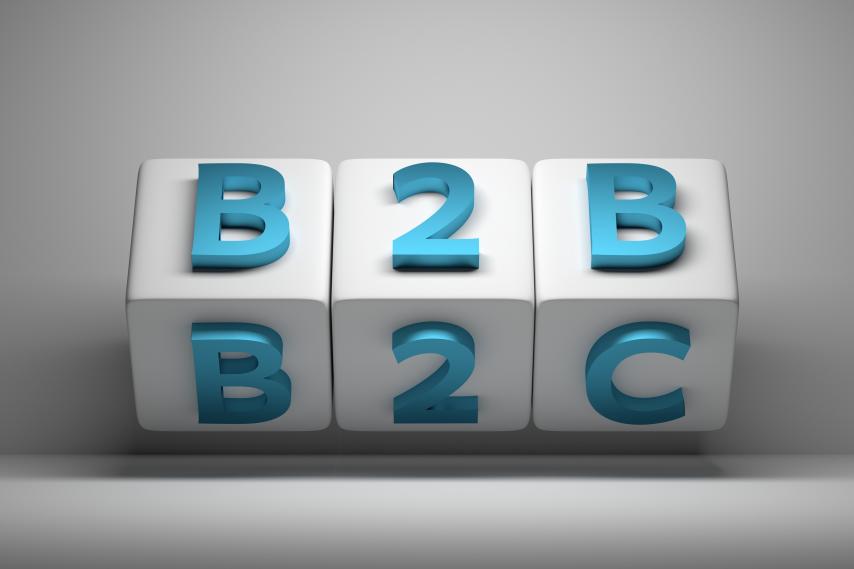B2B eCommerce Guide – All you need to know
In this B2B eCommerce guide, we'll take a look at different types of B2B eCommerce, consider who B2B eCommerce is for, how it differs from B2C eCommerce and dispel some common B2B eCommerce misconceptions. Find out all you need to know about B2B eCommerce.

B2B eCommerce – All you need to know
B2B eCommerce is an online transaction between two businesses, for example, between a manufacturer and a wholesaler, or a wholesaler and a retailer.
Although B2B businesses have traditionally been slow to embrace the benefits of eCommerce, B2B eCommerce is now a fast-growing sector. Over recent years, it has increased in popularity significantly and, since 2020, has become the main purchasing option for many businesses.
In 2020, the global B2B eCommerce market was valued at $14.9 trillion and it is predicted that, by 2023, B2B eCommerce will account for 17% of all B2B sales in the US, reaching $1.8 trillion.
Data from Wonderman Thomson revealed that, as of 2021, 49% of B2B buying across the UK, US, and China occurs online, while Gartner predicts that, by 2025, 80% of sales transactions between buyers and suppliers will be via digital channels.
In this guide, we’ll take a look at different types of B2B eCommerce, consider who B2B eCommerce is for, how it differs from B2C eCommerce and dispel some common B2B eCommerce myths.
Types of B2B eCommerce
Throughout this section of our guide, we will give information on the four main types of B2B eCommerce:
Wholesale
This type of B2B eCommerce is where a business sells goods in bulk to other businesses, online. So, for example, an online retail store would buy its stock from an online wholesale supplier.
This type of B2B eCommerce often enables businesses to buy products for a lower cost, meaning they can re-sell them at the retail value and make a profit. This model is widely used in a wide range of industries, including retail, food, and construction.
Manufacturers
Manufacturers produce finished goods and then sell them to B2B buyers such as suppliers, wholesalers, and other manufacturers.
Traditionally, manufacturers have sold their products to both wholesalers and retailers via offline channels. However, the growth of eCommerce now opens up a whole new world of opportunities, expands reach, and makes the sales process more efficient.
Distributors
Once manufacturers have produced their products, they can either sell them directly to the end customer, or work with a distributor who will sell their products for them.
Distributors are the third party between either the manufacturer and the wholesaler, or the wholesaler and the retailer. In addition to this, they also often take care of the marketing, sales, and services for buyers.
B2B2C
B2B2C (business-to-business-to-consumer) eCommerce is a type of B2B eCommerce that puts businesses directly in contact with consumers, eliminating the middleman between B2B and B2C.
Who is B2B eCommerce for?
Businesses in all industries use B2B eCommerce, including:
– Retail
– Food
– Electronics
– Construction
– Manufacturing
– Medical
B2B vs B2C eCommerce
What is the difference between B2B and B2C eCommerce? B2C eCommerce is the selling of goods from businesses to individuals, while B2B eCommerce is one business selling goods to another.
Whereas B2C eCommerce transactions are typically low value and high volume, B2B eCommerce transactions are usually high value and low volume. The majority of B2C prices are non-negotiable, while B2B transactions are often tailored to the customer with negotiable price points.
What to look for in a B2B eCommerce provider
Use the guide below to assess some of the key things to consider when looking for a B2B eCommerce provider:
Does it meet your requirements?
Does the provider’s B2B eCommerce solution meet your business’ requirements? Think about general requirements, such as market requirements and integrations, as well as technical requirements, such as security compliance and IT capabilities.
Does it support the relevant integrations?
As well as thinking about your business’ B2B eCommerce needs, you’ll also need to consider whether the solution can be integrated with your other systems, such as your ERP. This will avoid additional cost, maintenance, and complexity caused by siloed systems.
What does it cost?
Cost is an important factor to consider and it’s important that a provider’s solutions fit your budget. As well as the initial cost of the software, keep in mind other costs such as implementation and connection fees, customisation fees, and service fees.
Do they have relevant experience?
Does the B2B eCommerce provider have experience working with businesses in your industry? It can also be beneficial if they have worked with businesses of a similar size to yours, and with similar selling processes.
Are they a good fit?
As you’ll be working closely with your provider, it’s important that they are a good culture fit for your business. The ultimate goal is for them to become a partner that understands your way of working and can get you the best results.
What support do they offer?
It’s important your provider offers the support and training you need to implement and use your B2B eCommerce solution effectively. Consider what level of support they offer, how quickly they respond to issues, and if they provide any training.
B2B eCommerce success studies
Explore the case studies below to read about some of the B2B success stories we have supported:
Matthew Clark – Prior to moving to TrueCommerce, Matthew Clark was using a B2B online ordering platform that wasn’t able to match the company’s ambitions. Since it’s transition, Matthew Clark has benefitted from an industry leading B2B platform which goes beyond simple transaction processing and has increased digital sales, improved customer experience and provided a better customer experience.
Poole Lighting – Although Poole Trading was already seeing the benefits of offering its customers the ability to order online via a B2B eCommerce site, the continued diversification of its brands led to the need for individual eCommerce sites that better catered for the brands individual requirements. Since upgrading to TrueCommerce’s multi-site B2B eCommerce platform, Poole Lighting has increased online sales, streamlined its internal processes and improved customer service.
RH Amar – RH Amar did not have an online ordering facility for its customers prior to moving to TrueCommerce. When Covid-19 hit, the company’s digital transformation plans were accelerated and they subsequently chose the TrueCommerce B2B eCommerce platform. Following the launch of its online store for its B2B customers, RH Amar has benefitted from improved efficiency and customer service, whilst reducing its costs.
B2B eCommerce misconceptions
Although there has been a significant shift towards B2B eCommerce, there are still a number of B2B eCommerce misconceptions surrounding the industry.
In this guide, we will explore some of the most common B2B eCommerce misconceptions:
B2B customers don’t want to shop online
People often envisage B2B buyers as older, traditional individuals who won’t want to shop online and still favour offline methods. This is no longer the case.
B2B buyers are increasingly millennials, who are not only open to buying online but actually prefer it. According to a recent report, in 2020 almost half of B2B buyers were millennials, 44% of millennials are making purchasing decisions, while 33% say they are key influencers or recommenders in the ordering process.
The majority of B2B companies don’t offer eCommerce
Another common B2B eCommerce misconception is that most B2B companies don’t offer eCommerce. This is far from true.
Today, around 65% of B2B companies offer eCommerce services. B2B sellers are now more likely to offer eCommerce sales channels than in-person selling, in response to customer demand.
eCommerce isn’t for high-cost purchases
In the early days of eCommerce, there was a certain amount of hesitancy surrounding buying high-value goods online. However, that is no longer the case and today it is standard practice to buy high-cost items via eCommerce platforms.
eCommerce makes it difficult to build relationships
Many companies are concerned that eCommerce doesn’t have the same human element as traditional sales methods, making it difficult for sellers to build valuable relationships with their customers.
This doesn’t have to be the case. It is still possible to engage and build relationships with customers, and ensure they receive a personalised service — just in a different way to face-to-face interactions. Through online channels, companies can learn about their customers’ behaviours and preferences. These insights can then be used to personalise the user’s experience.
eCommerce means price transparency
Some businesses are concerned that using eCommerce platforms will mean that they have to reveal the full details of their B2B pricing for the whole world (including their competitors) to see.
In reality, this isn’t the case. ECommerce gives B2B suppliers the option to offer customers quotes upon application or even showcase products to all users, but prices only to registered and logged-in users only.
Additional resources
If our B2B eCommerce guide wasn’t enough, you can find out more by using the list of links below or get in touch with our team today:
The benefits of B2B eCommerce
Reduce costs with B2B eCommerce
What is B2B eCommerce integration?
B2B eCommerce for ERP
B2B eCommerce for the distribution and wholesale industry
What are the best B2B eCommerce platform features?
How to find the best B2B eCommerce platform
Integrate online and offline sales with B2B eCommerce
